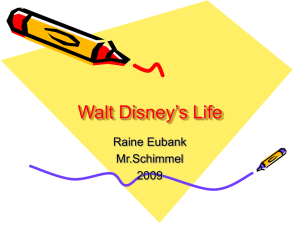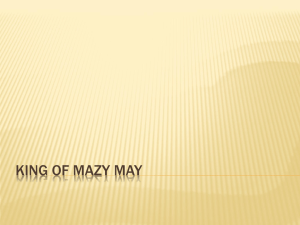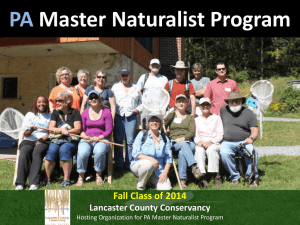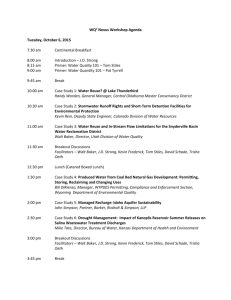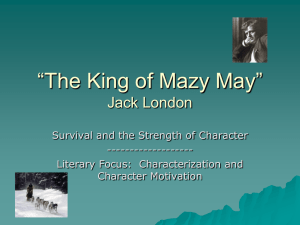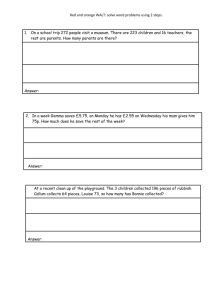Year 3 Medium Term Plan Autumn 2015
advertisement
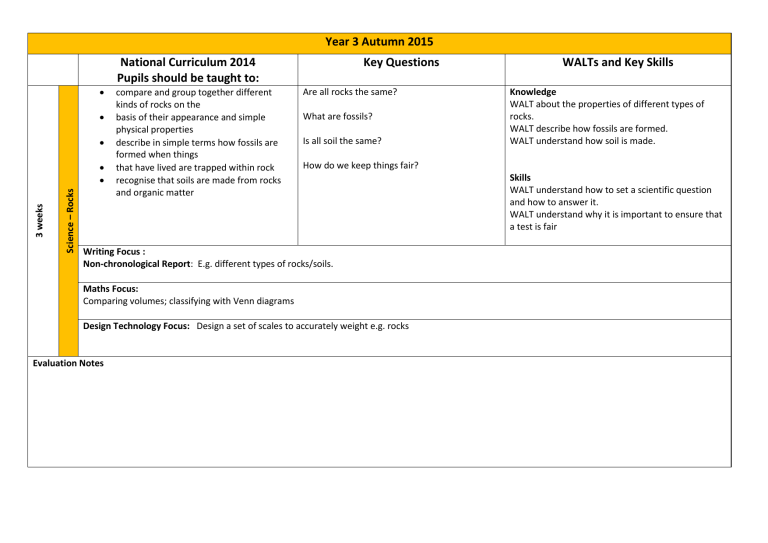
Year 3 Autumn 2015 National Curriculum 2014 Pupils should be taught to: Science – Rocks 3 weeks compare and group together different kinds of rocks on the basis of their appearance and simple physical properties describe in simple terms how fossils are formed when things that have lived are trapped within rock recognise that soils are made from rocks and organic matter Key Questions Are all rocks the same? What are fossils? Is all soil the same? Knowledge WALT about the properties of different types of rocks. WALT describe how fossils are formed. WALT understand how soil is made. How do we keep things fair? Writing Focus : Non-chronological Report: E.g. different types of rocks/soils. Maths Focus: Comparing volumes; classifying with Venn diagrams Design Technology Focus: Design a set of scales to accurately weight e.g. rocks Evaluation Notes WALTs and Key Skills Skills WALT understand how to set a scientific question and how to answer it. WALT understand why it is important to ensure that a test is fair Year 3 Autumn 2015 National Curriculum 2014 Pupils should be taught to: WALTs and Key Skills British History (taught chronologically) What techniques did early man use to survive? Stone Age to Iron Age Britain, including: WALT understand how early man gathered food How did these techniques change over WALT understand the importance of Bronze to early time? man WALT identify ways in which new materials were used Which is better Bronze or Iron? WALT understand why and how early man defended their territories. Why was Stonehenge built? History - hunter-gatherers and early farmers - Bronze age religion, technology & travel - Iron age hill forts 3 weeks Key Questions Knowledge Skills WALT understand how to answer historically-valid questions. WALT use sources of information provided to find out information related to our question. Writing Focus Instructional Text E.g. How to build an iron age hill fort. Maths in History None this topic Evaluation Notes Year 3 Autumn 2015 National Curriculum 2014 Pupils should be taught to: Key Questions WALTs and Key Skills How has the way we have used the land in the UK changed over time? Knowledge WALT locate major counties, towns and cities in the UK WALT locate major rivers and mountain ranges in the UK. WALT understand how land use patterns have changed over time. Location Knowledge – Location of major counties, towns, cities, mountain ranges and rivers in the UK. Geography 3 weeks Human geography Land-use patterns and how these have changed over time. How do rivers and mountains influence how the land is used? How has the size of our settlements changed over time? Writing Focus Descriptive writing – describe what it is like on a mountain top, next to a river, or in a city. Maths Focus Comparing and order numbers up to 1000; Add and subtract numbers up to 3 digits. Evaluation Notes Skills WALT report the results of our enquiries clearly using subject specific vocabulary. Year 3 Autumn 2015 National Curriculum 2014 Pupils should be taught to: Religious Education 1 weeks Christianity Writing Focus Maths Focus Evaluation Notes Key Questions What do people believe about the creation of our world? WALTs and Key Skills WALT Use guidance from programme of study Year 3 Autumn 2015 National Curriculum 2014 Pupils should be taught to: Key Questions notice that light is reflected from surfaces Where does light come from? find patterns that determine the size of shadows. How does light travel? What happens when light hits a surface? Science - Light 3 weeks How can we change the size shadow of an object? WALTs and Key Skills Knowledge WALT understand where light comes from. WALT understand how light travels WALT understand what happens when light hits a surface WALT understand how shadows can be formed and changed Skills WALT take accurate measurements using scientific instruments. WALT look for differences, similarities, changes and patterns to help us draw simple conclusions. Writing Focus Narrative – E.g. A story about The Shadow Maths Focus Measure and compare lengths in m/cm/mm. Tell and write the time from an analogue clock including using Roman numerals from 1 to 12, 12hr and 24hr clocks. Estimate and read time with increasing accuracy to the nearest minute; record and compare time in terms of seconds, minutes, hours and o’clock; use vocabulary such as am/pm, morning, afternoon, noon and midnight. Evaluation Notes
